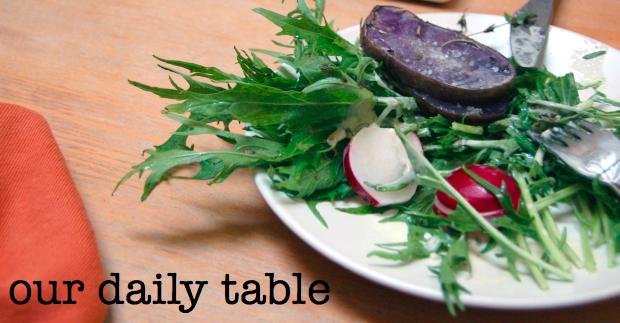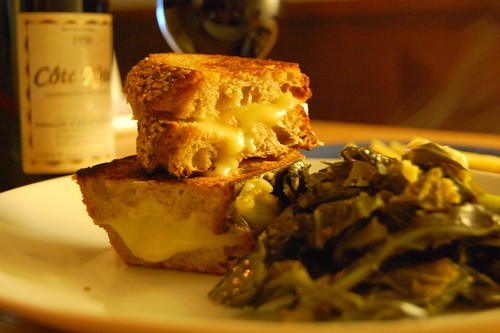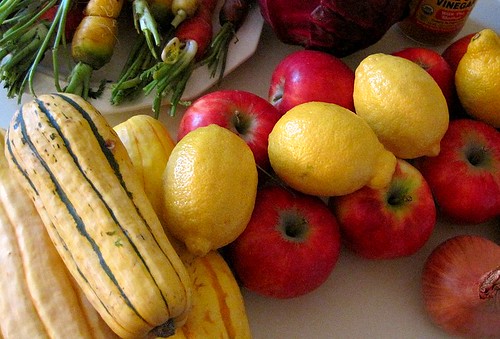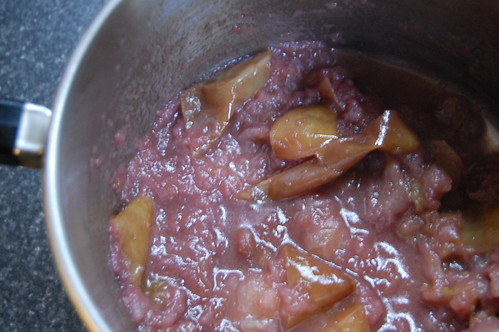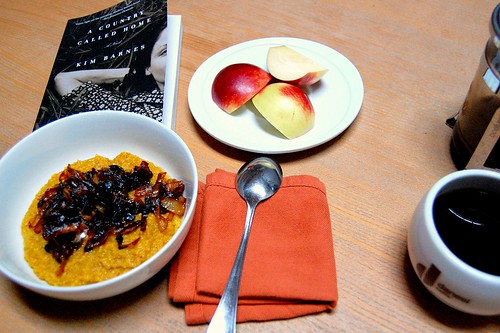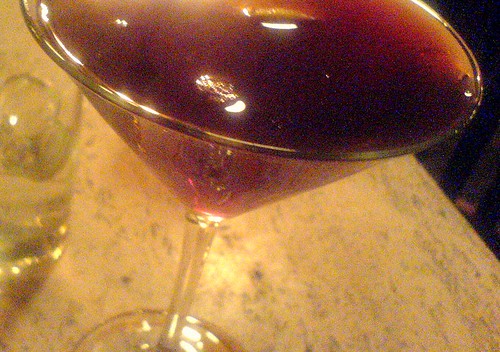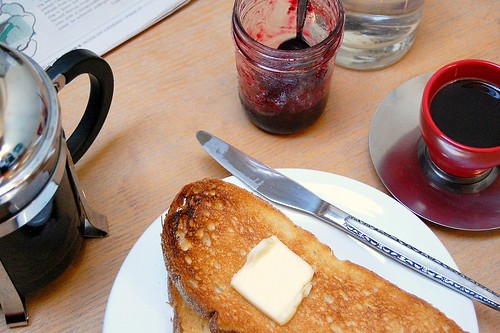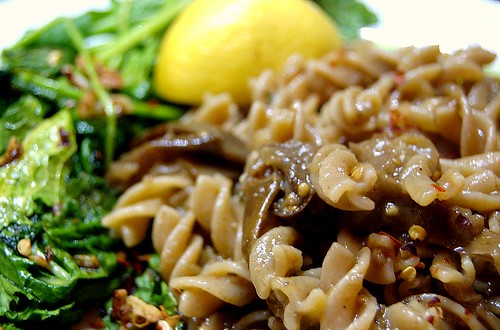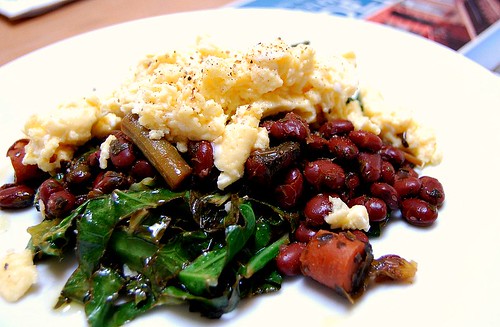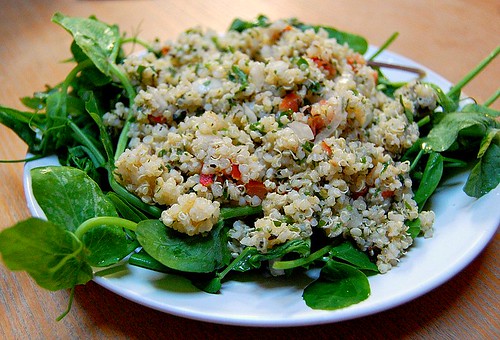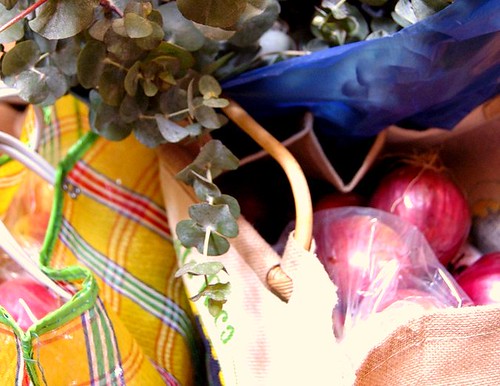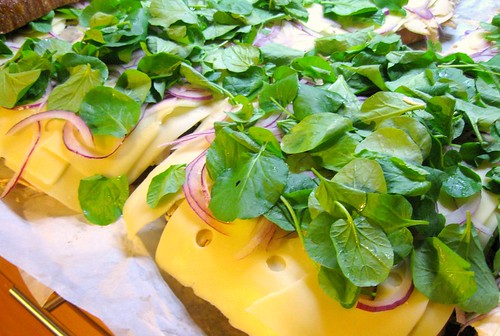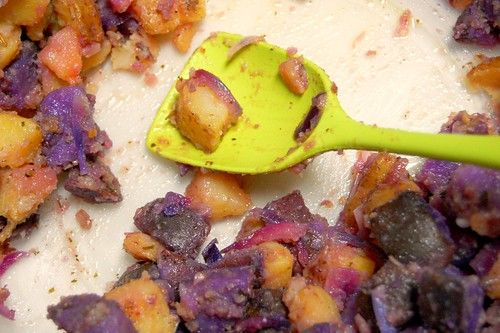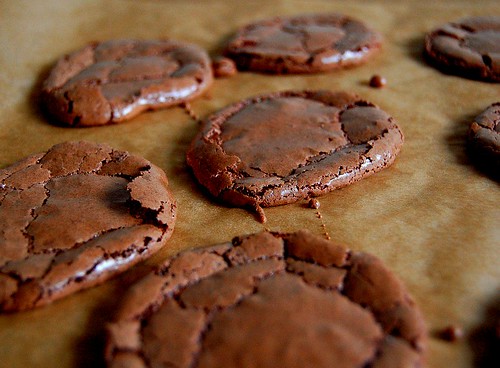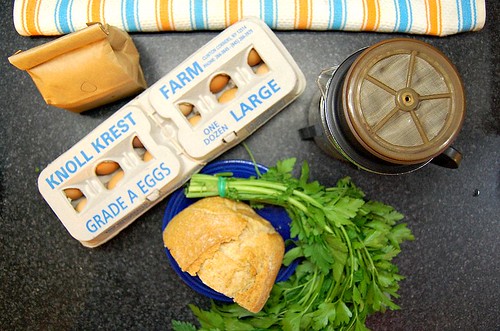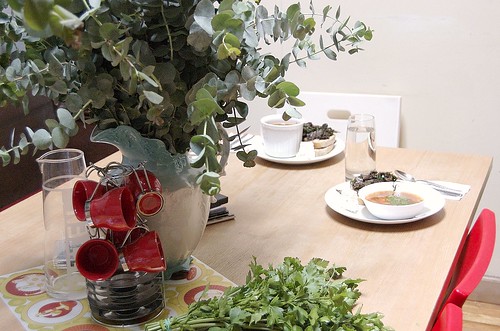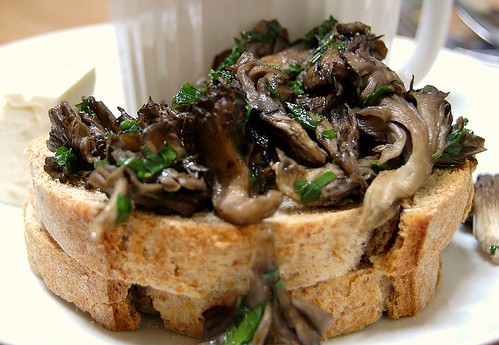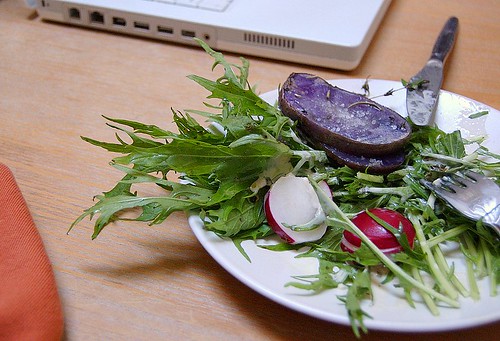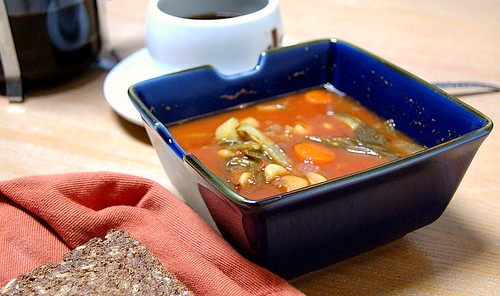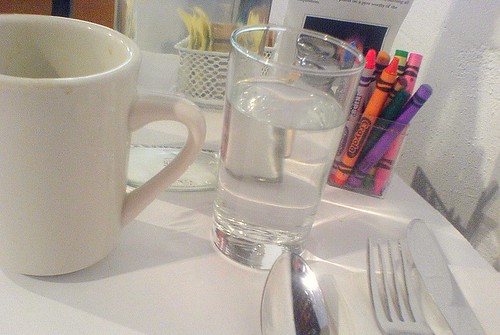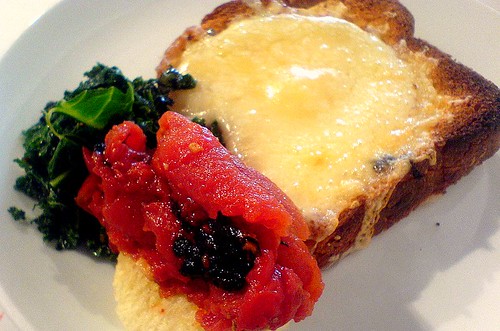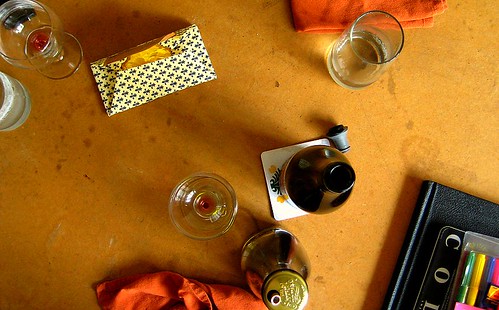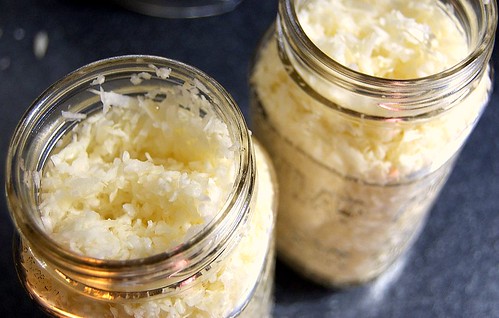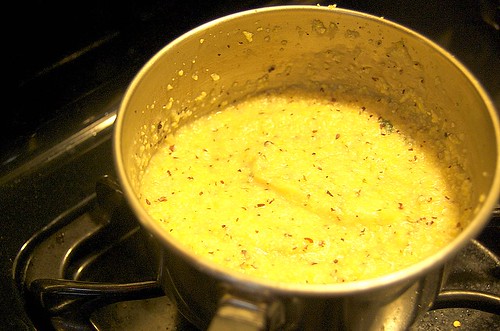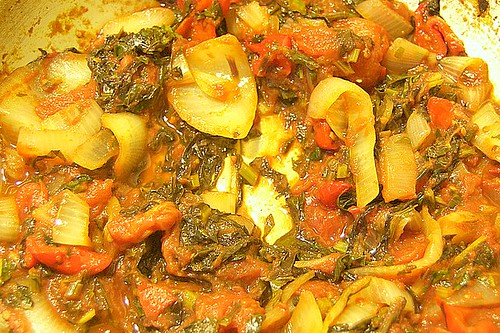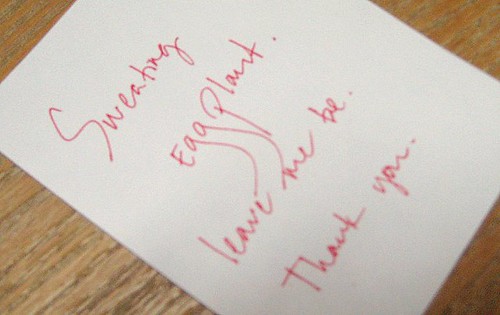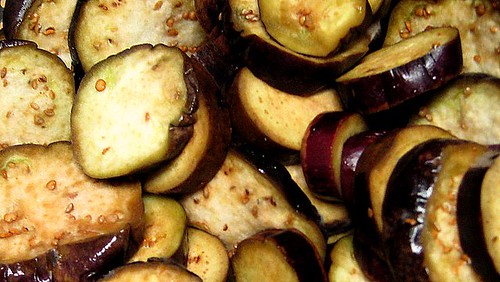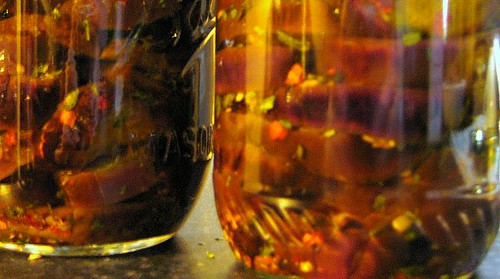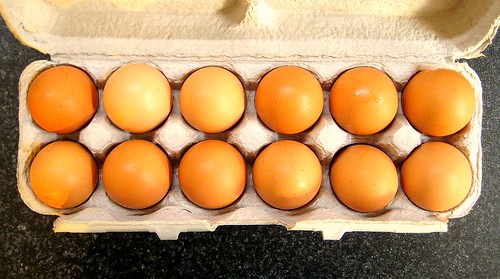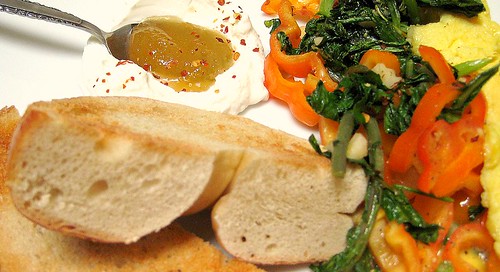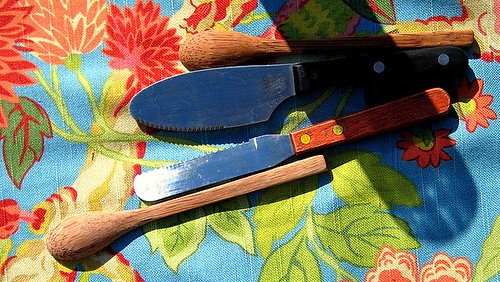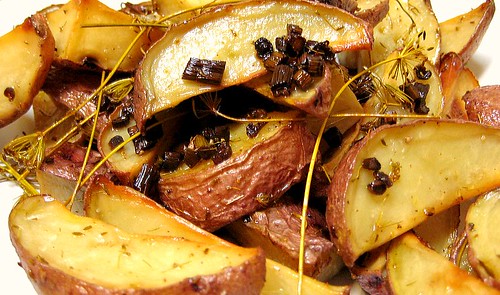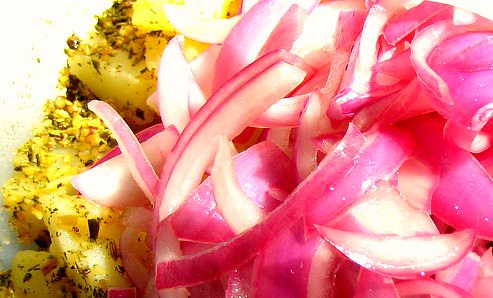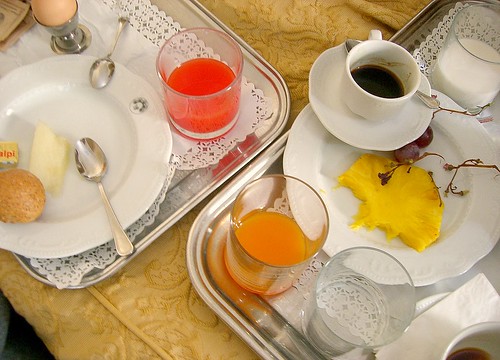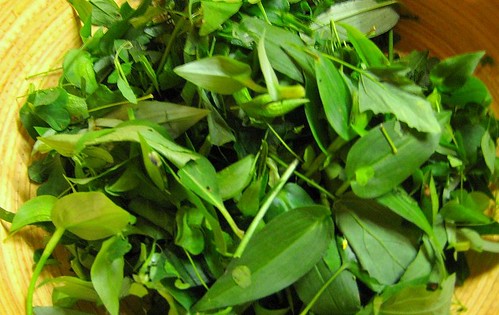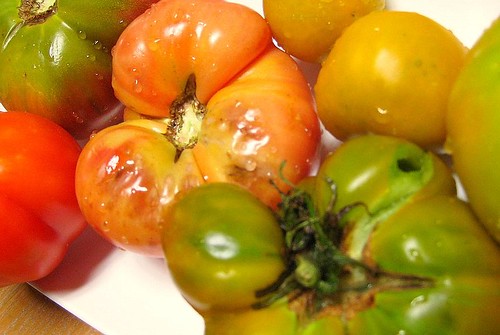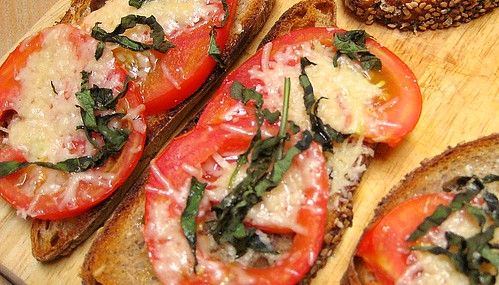Monday, December 21, 2009
The time.
Then a few weeks ago, on the first full day I've spent home in what felt like ages, I treated myself to something special. I walked down the block to my local wine shop, where I selected a 1998 Rhone Syrah -- a bit lean, but full of leather, spice and tannins -- then I marched into Bedford Cheese Shop and said to the guy, "I wanna make the best grilled cheese ever." He offered up little slivers of several types of cheese before I settled on Beeler Wildspitz Bio, an organic raw cow's milk cheese with a gulp of goat's milk. The flavor is intense, not unlike traditional Swiss cheeses but way funkier. I thought it would be perfect sliced onto Amy's seeded wheat bread, generously spread with the butter. With some collard greens and jazz, the night was a success.
But it was more that that, too. That night affirmed not just my joy of cooking, it reminded me of all the other magic: the actual meal itself, the people and places that help create it. I love chatting with the guy at the cheese shop, the girl at the market, or any number of my friends about what they're dreaming up in the kitchen. I seemed to have lost that in the daily hustle and bustle, and I'm sorry. To the friends who weren't afraid of the elephant, thank you.
Monday, November 30, 2009
Improvisation.
I wish I could've answered her with an assured "no," but in truth, I'm forced to improvise often -- from lack of planning, lack of proper ingredients (file under lack of planning), biting off more than I can chew, distraction. I thought of a salad I made recently for the opening of a friend's gallery: crispy delicata squash and shaved apple salad. If it sounds good it's because it was, but it was not what I intended. I planned a roasted delicata squash and shaved apple salad, buttery soft bits of squash that would melt in mouths of art lovers, tart bursts of apple. Then I burned the squash, prompting an internal debate over whether -- when entertaining -- it's better to have a table heaped with snacks (some nearly blackened) or a less-bountiful spread that's a sure thing. To my surprise, I chose the former, arguing that despite the crispy edges of the squash pieces, the salad was very good. So good, in fact, several guests asked for the recipe.
Of course, I would not have served it if I thought it was inedible, so it wasn't quite a miss. But it was close.
Crispy delicata squash and shaved apple salad
Ingredients
Three medium delicata squash, halved, seeded, cut into 1/4" pieces (skins on)
Two medium red-skinned apples
1/3 cup parsley, chopped
1/2 cup extra-virgin olive oil
3 tablespoons apple cider vinegar
Juice of 1 lemon
Salt and pepper, to taste
Pre-heat oven to 350 degrees.
In large mixing bowl, toss squash segments in 1/4 cup extra virgin olive oil, taking care that each piece is lightly coated. If needed, do this step in batches.
Place segments in a single layer on two baking sheets. Season with salt and freshly ground black pepper. Roast until underside of squash blisters and can be pierced easily with a fork (20-25 minutes). Allow to cool slightly (20 minutes).
Meanwhile, core and thinly slice apples. In a large mixing bowl, toss apples with lemon juice and parsley. Add cool squash, remaining olive oil and vinegar.
Season to taste.
Serves 10-12.
Tuesday, November 17, 2009
When life gives you apples.
Let's just say you go there. And the next morning, as you contemplate the contents of your fridge and weigh them against your previous night's meal, consider those two apples on the top shelf, the bruised and mushy ones you meant to throw away last week. Pull 'em out, because you're going to eat them, but first you're going to turn them into a quick and delicious apple sauce. With wine. This recipe takes less than 25 minutes, plenty of time to brew a pot of coffee, boil an egg, toast a few slices of bread and gather some reading materials. Relish the goodness of this meal: rustic -- like Sfoglia -- in a different vain.
Call your grandmother.
Applesauce with cinnamon and red wine
Ingredients
2 medium red-skinned apples, cored and quartered*
1 tablespoon extra-virgin olive oil
1/4 cup red wine
1 teaspoon cinnamon
1 pinch salt
Heat olive oil in a medium-sized sauce pan over medium heat.
Add apples. Cook, stirring every few minutes, until apples start to break down (5 minutes).
Add wine. Cover and continue to cook until apples soften completely (10-15 minutes).
When done, apples will mash easily with a fork.
Stir in cinnamon.
Serves 2 if you're feeling generous.
* Note: I suppose you could peel the apples, but it's more work, and it is breakfast, and the skins help maintain a rustic charm.
Thursday, November 12, 2009
Thursday morning No. 9.
The novel is set in rural Idaho and is largely about relationships -- mostly familial, some platonic, a few romantic -- and I found them engaging. But it's the landscape that really drew me in. The vast potential of the land, and the meals that it inspired: coffee brewed over campfires, foraged berries and bitter greens, newly-caught fish gutted and roasted alongside rivers, tasting of earth and muck and salt. There were less-rustic meals, too: simple omelettes, steaming bowls of oatmeal, roast chickens and pies. In one chapter, a character inventories the various gravies cooked for him over the course of his childhood: "Redeye gravy stained with ham drippings and spiced with coffee grounds. White gravy thick with flour; brown gravy made rich with Floral Bouquet. Bacon gravy, sausage gravy, turkey gravy -- any bone would do, any carcass stripped, simmered, the broth set to cool, the fat rising and skimmed." Never have I craved biscuits so badly. The mention of fried apples made me weak in the knees.
It was no surprise, then, that I woke this morning craving something hearty, a camping meal. I thought again of fried apples and a bowl of farina, before remembering something better. I've been saving this recipe for curried oats with caramelized onions, waiting for the right day, the perfect mood, enough time. Caramelizing onions takes a good deal of it (mine took more than an hour), so I made a large pot of coffee to keep me company. And while I watched the segments turn from white to golden to brown then black, I reflected on my recent trip to Oregon, artisan coffee, the smell of wet leaves after a good rain, leisurely drives out to Dundee, toast. I was so entranced by memories and onions, I nearly forgot the accompanying grains. Instead of oats, I opted for farina, which I spiced with cinnamon, coriander, cumin and turmeric. A little salt. Then, at last, a heaping spoonful of caramelized onions. Crunchy and sweet, they bound to the farina for perfect savory bites. It was a special meal, and it left me warm, happy, thankful.
Saturday, November 7, 2009
Welcome to The Stock Agency.
Tonight we are celebrating years of dreaming and months of hard work. I designed this menu with Tamara -- a vegetarian -- in mind. Some of our best times have taken place around a table, breaking bread, trading stories.
All food is local (most is organic) unless otherwise noted:
Spiced olives, Grand Central Bakery baguette.
Roasted hazelnuts.
Rainbow carrots, sea salt.
Cypress Grove Humboldt Fog.
Hummus, cracked pepper crackers.
Roasted beets, thyme, olive oil, sea salt.
Crispy delicata squash and shaved apple salad.
Sautéed shitake mushrooms, elephant garlic, parsley.
Autumnal sangria -- apples, brandy, pears.
Thursday, November 5, 2009
Thursday morning No 8.
Just thinking about airport food makes me grumpy, but that's not the only reason I travel with a sack lunch. Yes, I like to know where my food comes from, and yes, I like to eat as many fresh and unprocessed foods as possible. But I also prefer to eat on my own terms -- and often -- and I've found both difficult and expensive when traveling. On a recent trip home from Southern California, after downing the bag full of snacks I'd packed before take-off, I was forced, upon arriving in Dallas for my layover, to eat at Chili's. And it was awful. Shuffling unsatisfying bites of iceberg lettuce, mealy tomatoes and pre-packaged shredded cheddar cheese between my plate and mouth with a plastic fork, I vowed next time -- and forever after -- I would pack enough for several meals. The food I packed for today easily stretched into three.
Discussing food for travel last week with a chef friend, she mentioned that she likes to use pre-packaged cartons of arugula to pack her travel meals; I love and recommend this tip. I don't often buy packaged greens, but many come in bio-degradable containers, which make them perfect for care-free travel (no need to worry about finding a recycling bin, or getting your favorite piece of Tupperware home). To build my lunch, I removed half the arugula from my container to make room for other food stuffs. I then added one cup of raw almonds, one cup of oil-cured olives, a few ounces of fresh goat cheese, some prosciutto and a whole lemon. It was like a bento -- a super-sized bento -- but still… Because I did not dress the greens, the arugula stayed crisp and delicious. I ate some wrapped in a slice of prosciutto with a dollop of chevre and a few olives. Later, I bought a bagel and made a sandwich. Along with a cup of Earl Grey tea, I was just as happy as I would've been at home. I admit I would've preferred flatware, but a plastic knife is surprisingly effective against a whole lemon. I cut the tip off mine, then pierced the flesh with my fork to release a little juice for my greens. When I was done, I used a little more lemon juice to clean my hands before attacking a bar of chocolate I brought along. Nibbling on a few squares, I found myself thinking ahead to next week and my trip home. What could I add to spice things up? What would you pack?
Tuesday, November 3, 2009
Looking forward.
Bike rides
The Brooklyn Academy of Music
Dinner parties
Letters
Manhattans
The Paris Theater
Pasta fagioli
Quince
The Russian and Turkish Baths
Sweet and sour (onions, raddichio, soup, etc.)
Thursday, October 29, 2009
Thursday morning No. 7.
I received a text message the other day from a friend that reminded me to "smile eat walk love." Then: "there's nothing more than that." So simple, and so true. Sometimes we need to go the simple route, like I did this morning. A full French press and my new coffee set, two slices of perfect sourdough toast, generous pats of butter and my aunt's triple berry jam. WNYC. And because few meals feel complete without a little company, my old friend the World Wide Web.
Tuesday, October 27, 2009
Anything pasta, even with eggplant.
Last week, faced with more eggplant from my CSA share, I attempted a pasta dish similar to one typically served in early summer, at the beginning of eggplant season. Spaghetti di melanzane, or spaghetti in eggplant, is a delicious, light and simple pasta perfect for warm weather. At Sfoglia, where I once worked, they top theirs with ricotta salata, and it adds a nice tang to an otherwise earthy dish. I didn't have any ricotta salata, and I was out of spaghetti. But I did have some hearty whole wheat fusilli, and I thought it would hold a chunky expression of this dish nicely.
I started by roasting several eggplants -- thinly sliced, skins and all -- in extra-virgin olive oil with a few whole cloves of garlic. After 35 to 40 minutes, they were almost oozing and I removed them from the oven, transferred them to a mixing bowl, and smashed them with a little more extra-virgin olive oil, a squeeze of fresh lemon juice and a little pasta water. Then, I added my al dente fusilli and some crushed red pepper flakes. The whole wheat pasta made for a much heavier meal than the one I recalled. But, it was perfect for a mid-autumn night: filling and flavorful. I just might make this one more time. I do have a few more eggplants, and a mean hankering for anything pasta.
Monday, October 26, 2009
Hot apples for raw kale.
Over the weekend, I was sautéeing some apples, intending to put them atop hot cereal. But when my roommates arrived home with our CSA share, and in the bag was a gorgeous bunch of kale, I changed my plan. After washing and drying a few leaves, I cut them into chiffonades. Then, almost spontaneously, I poured the hot sautéed apples -- extra-virgin olive oil and all -- into the salad bowl. I added a pinch of salt and a squeeze of lemon, and I tossed the salad a few times. The heat from the apples softened the raw kale ever so slightly, and their sweetness combined wonderfully with the earthiness of the greens. The lemon kept things bright, the salt honest. If I'd had some walnuts, I would've toasted them and added them for texture. Raw red onion and a little chevre might find their way into the next incarnation. And there will be many more incarnations...
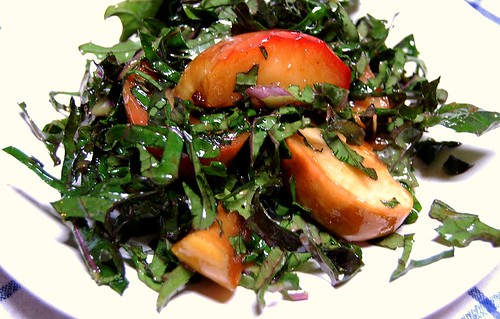
One bunch kale, washed and dried
5 medium apples
2 tablespoons extra-virgin olive oil
2 tablespoons sucanat
Juice of 1 lemon
1 teaspoon salt, plus more to taste
Chiffonade kale leaves -- removing stems -- and set aside in large salad bowl.
Core and quarter apples, immediately tossing with juice of half a lemon to prevent discoloration. (I prefer to leave the skins on.)
Heat 2 tablespoons of olive oil in a medium-sized skillet over medium heat, add apples. Cook, stirring every few minutes, until apples start to break down (5 minutes). Add the 1 teaspoon of salt and sugar. Continue to cook until apples soften completely (10 minutes). The olive oil, lemon juice from the apples and sugar will bind into a loose sauce.
In a large salad bowl, combine kale with hot apples. There should be enough liquid remaining in the pan to dress greens. Add remaining lemon juice.
Salt to taste.
Serves 4.
Friday, October 23, 2009
Something different.
Everybody's talking about Jonathan Lethem, while I'm reading poetry.
And listening to and loving "Album" by Girls, especially this song.
While sighing over photos at The Blue Hour.
And sipping the ultimate fall cocktail, rechristened The Second Line, exclusively at Buttermilk Channel.
All the while longing to go to Paris, but beyond excited for Portland.
Thursday, October 22, 2009
Thursday morning No. 6.
Sometimes, I get ahead of myself. And that's when I take a deep breath (mom, that's for you).
Next, I put the kettle on for coffee. While waiting for the water to boil, I rinsed and chopped two gloriously large collard leaves. These things were bigger than my head, and I knew they alone contained the power to heal. But I went further. In a large skillet, I warmed two tablespoons of extra-virgin olive oil and added the ribbonlike greens. There were faint pops and sizzles, as they softened in a pinch of salt. After three minutes, I added a minced clove of garlic, and after a minute more, the juice of half a lemon. In a separate pan, I quickly soft-scrambled two eggs in a dollop of butter (all you have to do is stir them a few times over medium heat; I like to add a little salt). I had some kidney beans that had been cooked in a million herbs. They were part of an incredible soup, but today they were strained and piled atop my greens. The eggs followed, with three twists of the pepper mill. Breakfast, at last, was bright, buttery, crunchy, earthy, salty and sweet. It made me feel alive. I easily forgave the unfortunate toast.
Wednesday, October 21, 2009
A twist on tabbouleh.
Shopping my neighborhood markets, I had a hard time finding bulgar. A friend suggested I use couscous, but I prefer quinoa to most grains for its nutritional benefits. I was able to find gorgeous local onions and parsley at the farmer's market, but I was forced to buy mint and tomatoes at the supermarket and so scaled back on both for this recipe. This made for a tabbouleh-style salad with considerable more bulk. Although I typically eat salads such as this one in the summer, especially a green-heavy tabbouleh, variations are still possible for the coming weeks. I plan to make a version that eliminates mint and substitutes raw grated beets for tomatoes. Finely chopped kale and even apple make delicious additons, too. I like to make grain-based salads in advance, and package them in individual servings for a grab-and-go lunch.
Tabbouleh-style quinoa salad
Ingredients
1 cup dry quinoa, cooked and cooled to room temperature
1/2 medium yellow onion, diced
1/4 cup mint, chopped
1 bunch parsley, chopped
1 medium firm tomato, seeded and diced
1/4 cup extra-virgin olive oil
Juice of 1 lemon
Salt, to taste
In a large mixing bowl, combine quinoa, onion, mint, parsley and tomato. Toss lightly.
Add extra-virgin olive oil and lemon juice. Toss until coated.
Season to taste.
Serves 4.
Tuesday, October 20, 2009
Unsung heroes.
I am not a chef, nor have I ever claimed to be. But having worked in my fair share of restaurants, I wasn't going into this thing blind. First, I wrote a menu: brown bag lunches gone gourmet. I'd make turkey sandwiches on Sfoglia bread with meat and cheese from Urban Rustic, and my salt and vinegar potato salad. I'd buy apples from the green market, and bake cookies (this is -- by far -- the funniest part, because I hate following directions, which makes for horrible baked goods; I literally googled "Orangette easy cookies" to find this recipe, and it still proved taxing). I needed a vegetarian option, so I dreamed up little containers of homemade hummus and tabbouleh-style quinoa, along with the aforementioned apples and baked goods. I envisioned my lunches to be a grown-up twist on a childhood favorite. They would be delicious and healthy and sourced locally. Best of all, they would be affordable, costing $7 per person. It sounded so good and easy, until I realized how little could be done in advance. Fresh equals good, which meant the food needed to be prepared within 48 hours of the event. There was no way I could do that by myself. That's when my heroes stepped in.
There was Chris, who helped carry 50 pounds (maybe more) of produce home from the Union Square green market. On Thursday, while he and our friend Alex shopped for paper goods, I made 25 pounds of potato salad, and there was a moment when, squatting over two stock pots, mixing the stuff with gloved hands, I thought I'd break down then and there. When I confessed this to my coworker Jon later that night, he offered to help the next day, his day off. And he did; he chopped and listened and stuck around after I scolded him for being messy. With his help, I baked roughly 120 cookies, and packaged 51 containers of potato salad, and 12 containers each of hummus and tabbouleh. Later that night, my brother delivered fresh-baked bread, and Chris returned to help with the sandwiches, which we layered with olive oil, red onion and watercress. After they were wrapped, I sent Chris to bed, and I packaged the brown bags and grouped them accordingly. This ended up taking the most time, because I needed to be careful not to break the cookies and I wanted them to be beautiful. And they were. Almost too pretty to eat, and just like the ones my dad packed me as a kid, full of goodness and love and even a little hope. Another friend, Seth, helped transport them, and Chris reported them a success. I got word as my roommate Michael was reviving me with coffee and washing the dishes I dirtied.
Unsung heroes New York over, I could not have done it without you. And believe me, I'll never do it again.
Thursday, October 15, 2009
Thursday morning No. 5.
Wednesday, October 14, 2009
Some hints of gladness.
Just when I thought things couldn't get better, I received an invitation to afternoon tea, complete with fresh-baked scones, jam and whipped cream. I plucked several branches of eucalyptus and bundled them with twine. I grabbed a sweater and I set out. Walking through Tompkins Square Park to my friend's I kept thinking, almost singing, Oh, how I love the goodness inspired by days like this one, days when my own lust for life catches me off-guard and I'm left smiling like a fool at any stranger willing to make eye contact.
Tuesday, October 13, 2009
Editor's note.
I am not a vegetarian, and, at the moment, I have no interest in being one. In my late-teens and early-20s, I was a vegetarian for a split second, and looking back I see my commitment was half-hearted and ill-informed. I lacked conviction. I sometimes ate fish, and I doubt when dining out I ever inquired about exact ingredients and stocks and such (I assure you, as a service professional, vegetarians should always inquire about the stock used in their food). I ate a lot of starch and dairy, and I might've been slightly anemic for it, although I did take iron supplements. I know, for sure, that I've been eating meat since 2001; I remember the steak and bottle of Zinfandel that did me in.
That said, regular readers may have noticed I eat a lot of vegetarian -- even vegan -- meals (above is a picture of my lunch: mizuna and radish in buttermilk dressing with roasted purple potatoes). I live with a devout vegan, a pescetarian, and my other roommate is a lot like me: we'll eat meat, but it's not a priority. I'm rarely inclined to do so at home, because I like to cook things that we can all enjoy, and I've learned so many ways to do that. Eating meat is certainly not something I think a lot about, except when I'm entertaining guests or I feel like I'm eating too much, which might amount to four or five servings per week.
I've heard all the arguments in favor of vegetarianism and veganism; they make sense. Eating a plant-based diet is better for your health; it's also better for the environment. I'm all for both, and eating a mostly vegetarian -- largely vegan -- diet makes me feel good. But right now, at this point in my life, mostly is the best I can do. I'm open to eating all things, especially if I know where they come from. That goes for my dairy, eggs, fish, meat and vegetables. Being an educated consumer is a big committment and one of my top priorities. It's guided me to the place I am today (as a writer, thinker, cook and engaged citizen), and I expect it will continue to do so in the future.
Monday, October 12, 2009
Soup re-imagined and reboiled.
Those instructions, memorized and long-ago re-imagined, are the basis for most of the soups I make today. I start with an onion, a few carrots and a couple stalks of celery, then I add whatever is on hand. The other day, I had a bag of bok choy from my CSA share, and I gambled on adding it to the pot. I had some radish greens, too, and as I watched them wilt, I envisioned cannellini beans and tomato. Cans of both went into the pot, along with two bay leaves, a handful of dried basil and a few sprigs of fresh thyme. The result was a simple and hearty faux ribollita, one I've been enjoying more and more every day. The bok choy retained a wonderful crunch, while the tomato and white beans are sweet, a little buttery and comforting. I like the idea of having a pot of soup on the stove at all times, one like this one; it's vegan, so can sit out all day, and it can be added to and reboiled. Maybe it's a little old-fashioned. But so are coupons and newspapers and many other things I love.
Faux ribollita
Ingredients
1 large yellow onion, diced
2-3 medium carrots, scrubbed (but unpeeled) and sliced into rounds
2 stalks celery, washed and sliced
1 to 2 pounds leafy greens, washed and trimmed
2 15-ounce cans of cannellini beans, drained and rinsed
1 28-ounce can of crushed tomatoes
2 tablespoons extra-virgin olive oil, plus more to finish
2 tablespoons dried basil
1 tablespoon fresh thyme
1 tablespoon salt, plus more to finish
2 bay leaves
In a medium-sized stock pot, heat extra-virgin olive oil over medium heat, add onions and a pinch of salt. Cook until onions become translucent (2 to 3 minutes).
Add carrots and celery. Cook until they begin to soften (3 to 5 minutes).
Stir in leafy greens. When the greens begin to wilt, fill pot with water (or stock) until the water line is roughly two inches above vegetables. Bring to a boil.
Add basil, bay leaves, thyme and remaining salt. Simmer 30 minutes, then cool.
Add beans and tomato, and reboil. Salt to taste.
Serve with a drizzle of extra-virgin olive oil and a nice piece of bread.
Soup will reduce and thicken with each reboiling.
Serves 6-8.
Thursday, October 8, 2009
Thursday morning No. 4.
I love my Brooklyn neighborhood for many reasons, but especially for a handful of restaurants I would gladly eat at daily. One of them -- Egg -- is my go-to for breakfast, and not because it's a block away (although that is very nice). I like Egg because they give you crayons and your own French press with coffee so strong it makes you spin (that's a good thing). I like their pretty staff and the music they play while I wait (today it was Pavement). I like that the restaurant runs a farm outside the city on which they grow their own produce, and today there were little table tents announcing farm news (the lettuces are thriving and they torched their blighted tomato plants!). I love their menu. It's simple and honest and consistently great. They call my favorite dish Eggs Rothko, and it's essentially a grown-up version of what most people know as Eggs in a Basket. To make it, you need a thick piece of brioche with a hole cut in the center. Cooked in that hole is an egg, and melted on top is a slice of Grafton cheddar. I normally fry my mine, but Egg's version is easy-cooked and light. The Rothko is served with a gorgeous spoonful of broiled sweet tomatoes, and a choice of meat or seasonal vegetable. I opted for the latter, which today was sautéed ribbons of kale in a little olive oil. It was a delicious and far cry from milk toast, and yet so heart-warming. The only thing missing was mom.
Tuesday, October 6, 2009
The Everycook of the future.
By now, those who care about Gourmet's fate know the reason the magazine was closed is purely a matter of economics. The New York Times reported today Gourmet's ad revenue was down 43 percent this year, and its circulation was roughly two-thirds of Bon Appétit, its in-house rival who survived the cut despite being, in the minds of many of aforementioned bloggers, journalists and food industry personalities, the lesser magazine. Bon Appétit is for the Everycook, Gourmet for the, well, gourmand. "In choosing Bon Appétit over Gourmet," The Times said, "Condé Nast reflected a bigger shift both inside and outside the company: influence, and spending power, now lies with the middle class." Are we to assume, then, that the middle class isn't on the same page as the rest of us?
I consider myself to be very much a part of the middle class, and the idea of a luxury magazine not appealing to me is absurd on many levels. First and foremost, to me Gourmet was not a luxury magazine. It appealed to food lovers and travelers on a deeper, more sensual and serious level; if that's luxurious, so be it. Taste exists outside of class (surely there are New Yorker readers who did not go to college, classical music aficionados with nothing more than a keen ear for what they know to be good). I once attended a cocktail party at which a middle-aged textile designer was lamenting the string of designer budget lines being sold at Target. In his eyes, good design was not for the masses, but for the well-appointed. To that I shouted, Garbage!
The real sadness, for me, is the closing of another publication for which I will never write. That's what I raised my glass to last night (and that inspired a whole other conversation about the future of print media, in general). Clearly, I think blogs are important, but if they are the death of print media, then shame on me and all of us. Show me a blogger who wants to go it alone, and I'll show you 10 just looking for a way up and out. Yes, I write about food because I love both food and writing. Both make me very happy; both inspire and motivate. But I also write a blog hoping someone will take notice, and hopefully take a chance on me. With each magazine closure, an audience dies. And with it, they take a little of my hope that there is a future -- not just for me, but for all of us -- in this business.
Monday, October 5, 2009
Making haste.
Last weekend, I revolted by making sauerkraut. Not much of a revolt, I know, but I had this head of cabbage that was in desperate need of use, so I used a quick sauerkraut recipe I'd read a while back. All I had to do was shred the cabbage, pack it into glass jars, add a little salt and a little sugar, and top it all off with boiling water. Easy enough, but after I'd made my sauerkraut my friend Amy posted about wild fermentation. Clearly I'm not an expert on these things, and Amy's wisdom shows me I have a lot to learn. Still, my brief venture into the world of fermentation -- even if it now feels like cheating -- was sort of empowering. Over the next couple of weeks, I'm adding "check sauerkraut" to my Saturday to-do list. And when I have the time, I look forward to trying things Amy's way.
Quick, easy and shameless sauerkraut
Ingredients
1 head cabbage
1 teaspoon salt
1 teaspoon sugar
Salt and pepper, to taste (optional)
Shred cabbage (I use a food processor).
Pack cabbage into a large glass jar.
Add salt, pepper and sugar.
Fill jar with boiling water.
Allow to ferment four to six weeks.
From here, recipes differ. Some end. Some say do a water bath. I will be sure to address this in a couple weeks when my kraut is finished.
Friday, October 2, 2009
About that breakfast...
Confession: until last week, I'd never made polenta. It's always seemed so labor-intensive, and in that unpractical. In college, I would buy pre-made polenta to fry, but my vision involved creamy polenta, the kind that satisfies like steel-cut oats and wouldn't seem too out of place alongside poached eggs and coffee. My craving was fierce, and so I had no choice but to turn to the Internet. Turns out, making polenta isn't hard; it's boring. Other than salt and water, it requires only constant stirring, so I was forced to stand attention over the stove for roughly 30 minutes while the grains congealed. While I did this, I warmed a tomato sauce I had made days earlier by sautéeing (in extra-virgin olive oil) half an onion, one red pepper, and a healthy handful of washed, dried and chopped braising greens. Once these had cooked down, I stirred in one can of peeled and whole San Marzano tomatoes, which broke down into soft and tender chunks. I seasoned this to taste. (Sauces like this are easy to make and store. I prefer chunky sauces for their versatility -- they can be used atop pastas, polentas and other grains, and they make great bruschetta, too.)
As my polenta neared completion, I brought a small pot of water and a few dashes of vinegar to boil for poaching eggs. While they cooked (2 to 3 minutes), I smeared a generous spoonful of polenta onto a plate and topped it with a spoonful of tomato sauce. The eggs nestled perfectly into this, and -- when broken -- married the flavors in the exact way I'd hoped. It was comforting, savory and a little sweet, too. Most importantly, it was hearty, and some days demand a hearty breakfast. Considering the amount of time it took to prepare, I don't think I'll recreate this one too often. That said, yesterday's was my third helping.
Thursday, October 1, 2009
The Deather of Thursday morning.
The Deather
2 1/4 ounces Scotch whiskey
1/2 ounce Lillet Blanc
2 dashes Highland Heather bitters*
Absinthe
Muddle one cube sugar and a wedge of fresh lemon with bitters.
Combine with ice, Scotch and Lillet.
Stir, and pour into an chilled, absinthe-rinsed martini glass.
Garnish with a lemon twist.
Gothamist reports the contest a tie, but I still feel like boasting. I got 5 minutes with Rachel Maddow. Rachel Maddow made me a cocktail. Perhaps the best news: The Deather will be featured on the fall cocktail list at Buttermilk Channel. For political reasons, I may have to change the name. The Maddow has a nice ring to it, no?
* Note: Artisan bitters made for Buttermilk Channel in Brooklyn. Can be replaced with the traditional Peychaud's Bitters.
Tuesday, September 29, 2009
The eggplant experiment.
A few weeks ago, confronted by a dozen or so eggplants from my CSA share, I asked a coworker if she knew a way to preserve them. She suggested pickling, which sounded like a fine idea, except I've only quick pickled a few things -- garlic and watermelon rind -- so, of course, I had no idea where to start. My online research turned up a wealth of recipes and stories; like so many age-old recipes, each was slightly different. That, of course, empowered me to do what I do best. So, I took to the kitchen, and began to experiment. I used four or five small eggplants, thinking it would yield more than one jar; I should've known they would shrink. Ever the optimist, I reasoned it was good my test batch was small. It might, after all, taste awful, or worse make me sick (in all my reading, I found only one mention of botulism, and it was brief, essentially suggesting following the proper precautions and consuming eggplant within a few weeks. I also read that, if stored in the refrigerator, pickled eggplant is good for up to one year).
Thankfully, the experiment was a delicious success -- the eggplant was just vinegary enough and surprisingly firm in texture, although dripping with a slightly spicy olive oil. I'd added a few cloves of garlic to the pickling mixture, and crushed red pepper flakes as well as a small hot pepper to the oil. I also had added some fresh basil (this was a few weeks ago), which provided a gorgeous -- if not slight -- aroma. I ate the entire jar in one day (on a sandwich, with some mozzarella, as a side) and used the left-over oil to dress salads. Then, as soon as I got my hands on more eggplant, I made another batch. I spiced the second batch differently, using dried herbs instead of fresh and omitting the garlic, and it was just as good. I served it at breakfast the other day, something I'd never thought to do. Again, we ate almost the whole jar. Good thing I had doubled the recipe.
Pickled eggplant packed in olive oil
Ingredients
4-5 small eggplants
Sea salt
1 cup white wine vinegar
2 cups water
2 cloves garlic, peeled and whole (optional)
Crushed red pepper flakes
Dried oregano
Extra-virgin olive oil
Slice eggplants into silver-dollar sized rounds, put slices in a colander, and sprinkle generously with sea salt. Weigh slices down with a plate and allow to sweat for at least four hours (when sweating eggplant, be sure to put a deep plate under your colander to catch the run-off). This tenderizes the flesh of the eggplant and helps reduce bitterness. Remove excess moisture with a towel.
In a medium sauce pan, combine vinegar, water and garlic. Bring to boil.
In batches, boil eggplant slices for approximately 3 minutes. Set aside to cool.
In a sterilized jar, tightly layer cooled eggplant slices and chosen herbs.
Cover in extra-virgin olive oil.
Store at room temperature until opened. Pickled eggplant can keep in the refrigerator for up to a year.
Yields one 12-ounce jar.
Thursday, September 24, 2009
Thursday morning No. 2.
Eggs and toast is my favorite breakfast, and this variation -- poached eggs over sautéed greens with garlic and hot pepper -- took less than 20 minutes. While I brought the kettle to boil for coffee, I also boiled a small pot of water with an added dash of vinegar (I use rice, but white is fine). Then, in a heated skillet, I sautéed a handful of washed and dried radish greens in a tablespoon of extra-virgin olive oil. When the greens started to break down, I added a minced garlic clove, a pinch of salt and a big pinch of crushed red pepper flakes. When the garlic began to release that wonderful cooked garlic smell, I removed the skillet from the heat and dropped the bread to toast. By this time, the water was boiling. While the coffee steeped (I use a French press), I carefully poached two eggs. As they took shape (2 to 3 minutes), I drizzled our toast with a little more olive oil and topped it with the greens. I finished that with the eggs and a dash of black pepper. The coffee was ready, and Camera Obscura was playing that way they do. It was -- without planning -- exactly what I wanted.
Thursday, September 17, 2009
A new routine.
I was thinking about this, just now, as I chopped some leafy greens and a perfect orange pepper for an impromptu omelette. I love making myself a proper breakfast, but often I don't make time. It's a shame really, because sitting down to an omelette or a plate of pancakes is pure joy, especially when you can do it in your pajamas. I adore blogs such as Simply Breakfast, where a single image can capture a quiet morning, early light, ambition.
I am not a photographer. I like photography; I even took a few classes in college. But I am a writer, a writer who loves breakfast, and today I'm starting a tradition of my own: Thursday breakfast at my house, wherein I'll share a photo or two, and a little how-to. I hope you enjoy, and are inspired to treat yourself to something special and enjoy the morning calm. The omelette above I filled with sautéed garlic, greens, pepper and sun gold tomatoes (all from my CSA share). I served it alongside a toasted bagel and Greek yogurt topped with a spoonful of honey and red pepper flakes. I made myself a cup of China Rose tea, my favorite. And I licked my plate. You can't do that in a restaurant, which is why it's better I eat at home.
Wednesday, September 16, 2009
A potato salad for all seasons.
A month into my experiment, I came across a recipe on the consistently lovely Blue Hour blog: salt and vinegar potato salad. Like chips, but not fried. It was the answer to my summer dilemma, so I bookmarked the recipe and promised myself I'd make it as soon as I could. But as the days passed and I kept thinking about that recipe, I realized that potato salad, like mussels, has stipulations. Mussels need frites, and potato salad needs a party, preferably in the park, with a gentle bit of sunshine and a slight breeze.
Of course, my fry-free summer was shy on garden parties, due to travel, weather and that thing we call work. But last Monday, on what may have been the last day of summer, I whipped up 10 pounds of this salad for a little soirée in Prospect Park. And it was awesome -- the perfect complement to the fresh-shucked oysters and pulled pork sandwiches. The vinegar onions are much more subtle than you'd expect, almost sweet. And the oil and vinegar dressing was, as always, perfect. Thankfully, there was enough left over for me to eat two more helpings when I got home, at which point I made one last promise: I'm going to make potato salad an all-seasons food, because this salad is as good as French fries.
Salt and vinegar potato salad
Adapted from Gourmet
Ingredients
1 large red onion, cut into 1/4" segments and separated
5 pounds medium potatoes (Gourmet recommends Yukon Gold, I used russet)
1/2 cup extra-virgin olive oil, plus more to finish
1/2 cup plus 2 tablespoons apple cider vinegar
2 1/2 teaspoons Old Bay seasoning
2 teaspoons salt
1 1/4 teaspoons sugar
In large bowl, mix 2 tablespoons apple cider vinegar with 1/2 teaspoon salt. Add onion and toss. Marinate at room temperature, tossing occasionally, until onion softens and turns pink (1 hour).
In large pot, cover potatoes with cold salted water. Bring to a boil, then simmer uncovered until tender (20 minutes). Drain and allow to cool, then peel and slice into 1/2" wedges.
In separate bowl, whisk together Old Bay seasoning with sugar, 1 1/2 teaspoons salt, and 1/2 cup apple cider vinegar.
Add potatoes to onion mixture, and toss with vinegar mixture and extra-virgin olive oil.
Serve warm or at room temperature.
Serves 10-12.
Saturday, September 12, 2009
The morning after.
These are the same excuses I use for not cooking a certain meal or entertaining certain groups of friends. Like conversation and letter writing, dining (both in and out) is an art, and it's one I strive to practice well. These all are traditions that nurture familial bonds, friendships and romances. They inspire conversation and ideas. They nourish both literally and figuratively. I believe all this, but I believe this, too: "... I think parties are really the last refuge of the empty and shrivelled brain, and are more destructive to the body than cocaine and more destructive to the spirit than jail." Martha Gellhorn wrote that to Alexander Woollcott in 1942, the morning after. I take from it this: our time is precious, let us use it wisely.
Tuesday, September 8, 2009
Central Park, how green your garden grows.
The sturdy, tear-shaped leaves pictured on the lower right are from the Asiatic dayflower, which flowers a beautiful purple and has kernel-like seeds -- all edible. Sadly, my flowers had closed by the time I got home, but they reminded me of pea shoots in texture and a bit in flavor, too. The leaves, however, were so...weedlike, I opted to chiffonade them, making them easier to eat and prettier to look at. The lady's thumb and lamb's quarters were also pretty hearty, and Wildman warned us about the flowers on the former, which taste -- go figure -- like plant. Wanting the full experience and the health benefits of the latter (lamb's quarters is an excellent source of B-complex vitamins, beta-carotene, calcium, fiber, iron, potassium and vitamin C), I used everything I had of both, cutting and tearing where I found appropriate.
The most naturally edible looking of the foraged plants -- and by far the tastiest -- was the yellow wood sorrel, which looks like clover and tastes like lemon. Its delicate leaves were a welcome addition, but despite its presence I couldn't help but think, "This salad looks foraged from a compost pile." Quickly, I added the only other raw edible I foraged: a red devil apple from the apple trees behind The Met. These red-fleshed gems were new to me, and pretty tart on the apple spectrum. I picked up four or five (you can't very well erect an apple ladder in Central Park, so we shook a branch and collected ours off the ground), and I might bake the rest. I also read they make a lovely pink-hued hard apple cider.

Saturday, September 5, 2009
Something happened today...
I've seen a few things, and writing about them made me want to see more. It made me want to take a few more photos and keep a better journal (because this memory of mine isn't getting any better). It reminded me of my desire to speak other languages beyond being able to translate a dinner menu. But the truly exciting part -- the part that has me happier than a pig in...well, you know -- is that it affirmed a decision I made about a year ago to alter the way I live my life. At the time, I worked so much I hardly had time for my family and friends, let alone a little time away from home. I had fallen into a trap, and I was not that happy. And so, I mustered up some courage and I changed. I quit my job, and I did a little soul searching. I got a new job, and I started a few projects (Our Daily Table being one of them). I learned the difference between "my job" and "my work."
The changes have not come easily; I'd say that I am -- like this blog -- a work in progress. But I'm getting there. One step at a time, with a little help from my friends, my eyes and my heart open wide. If you've made it this far, thank you for indulging me. Now, let's get back to that business of food...
Tuesday, September 1, 2009
The heat goes on...
The above tomatoes aren't from California, they're from Garden of Eve Farm on Long Island. Just as I started to write off this year's tomato crop, my CSA share turned out some gorgeous heirlooms and slicing tomatoes. Typically when the weather is warm, my cooking amounts to little more than a few chops and slices, a drizzle of olive oil and a sprinkle of sea salt. The thing I am willing to turn on the stove for (and the dish I keep turning to for an easy hors d'oeuvres, quick lunch or savory side dish) is crostini, or bruschetta. As far as I can tell, the difference between bruschetta and crostini is in the treatment of the bread. For bruschetta, bread is rubbed with garlic and olive oil, and for crostini, it is not. I suppose, then, that bruschetta is a type of crostini, I also bet there's a nonna somewhere who will gladly correct me.
Crost -- err, bruschetta -- makes great use of tomatoes. Simply thinly slice bread (I like Amy's seeded wheat), rub each slice with a garlic clove and drizzle with olive oil, then top with tomatoes and Parmiggiano-Reggiano. I prefer to broil everything together -- allowing the flavors to melt into one glorious garlic-tinged cheesy tomato crouton -- and top with fresh basil. If you prefer your tomatoes a little sturdier, toast your garlic-rubbed and oiled bread before proceeding with raw tomatoes. When those are gone, you can substitute pickled eggplant or stewed peppers or whatever else comes to mind (raw corn, roasted peaches, poached apples, sautéed kale...I could do this all day).
Call it what you want. Just don't call me late for dinner.
